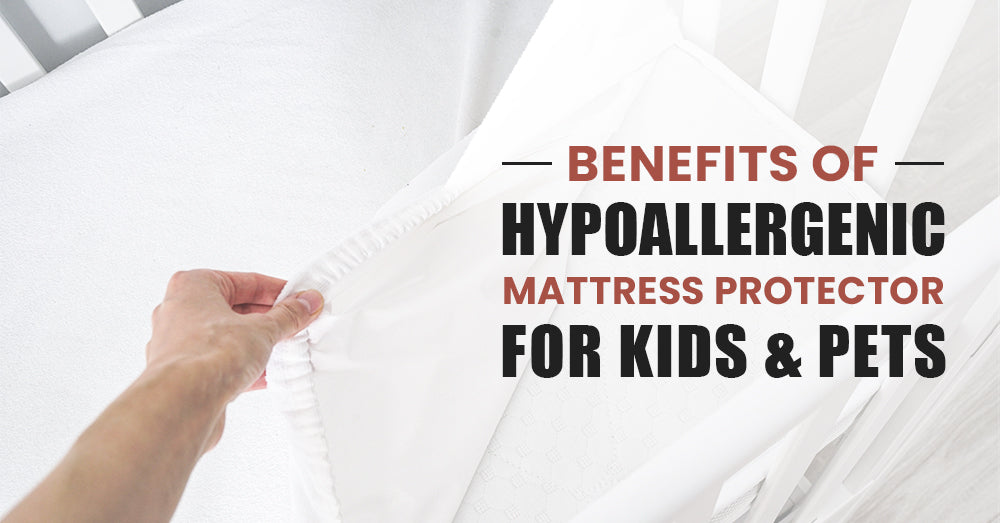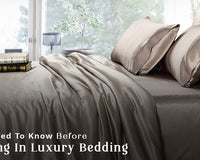Hey there, parent or pet-lover! When was the last time you thought about what’s really beneath your little one’s head or your pet’s paws while they sleep? Allergens, dust mites, spills—oh my! If you’re aiming to create a clean, cosy environment while protecting your mattress investment, a hypoallergenic mattress protector may be your unsung hero. We’ll dive into how this simple bedding accessory can enhance sleep quality, reduce allergens, and maintain your mattress in optimal condition.
What Is a Hypoallergenic Mattress Protector?
Imagine your mattress wearing a superhero cape—lightweight, protective, and always on guard. A hypoallergenic mattress protector acts just like that, creating a barrier between your mattress and sources of allergens, such as dust mites, pet dander, mould spores, and even accidental accidents or spills.
Health benefits abound, mainly if your household includes children who sneeze through the night or pets whose fur seems to multiply overnight. With this protector in place, you can seriously reduce allergens and promote healthier breathing—without breaking the bank.
Why Kids and Pets Need Extra Protection
Allergies and Asthma Triggers
In the UK, childhood asthma and allergy rates are climbing steadily. Dust mites thrive in warm, humid bedding environments and are a potent trigger for allergic reactions, including coughing, sneezing, itchy skin, and even eczema flare–ups. Suppose a child’s symptoms flare up more at bedtime. It could easily be due to allergens nestled deep in the mattress.

Pets add another layer of complexity. Dog and cat dander can aggravate asthma symptoms in people living with the condition, and pet hair absorbs moisture, allowing bacteria and mould to thrive. A hypoallergenic and waterproof mattress protector prevents your child from being exposed to these irritants nightly.
Hygiene and Slate Cleanliness
Kids spill drinks. Pets shed. Pet mess happens. A protector acts as a shield, preventing liquids from soaking in and causing odours, mould, or damage to the mattress. Regular washing of the protector is far easier than battling a stubborn stain or lingering smell in the mattress itself.
Benefits You’ll Love in Daily Life
Better Sleep Quality
Ever wake up with a scratchy throat or swollen eyes? That could mean allergens at play. With a hypoallergenic mattress protector, you reduce exposure to irritants, helping your household, especially children, breathe more easily and sleep more deeply.
Easy to Clean, Easy to Replace
A protector usually zips on like a duvet cover, slips into the wash, and emerges like new. You save time, keep things fresh, and avoid the hassle of cleaning the mattress itself.
Extending Mattress Lifespan
You’ve invested in a good mattress—be it for a child or yourself. That investment deserves protection! A waterproof or water-resistant protector keeps moisture and spills at bay, preventing mould growth or foam breakdown. A protector and a mattress? They make a perfect team.
Peace of Mind
Knowing that allergens, liquids, mites, and even pet accidents won’t reach the core of your mattress? That’s emotional security worth its weight in gold—especially in a busy, unpredictable family home.
Key Features to Look For
Not all protectors are created equal, so let’s break down what to look for when choosing one in the UK:

Feature |
Why it Matters |
|
Hypoallergenic Cover Fabric |
Look for tightly woven fabrics, such as cotton or bamboo blends, that physically block dust mites. |
|
Waterproof Membrane |
PU-coated or laminate membranes protect against spills and accidents. |
|
Breathability |
You don’t want a protector trapping heat or moisture. A breathable design helps preserve both comfort and longevity. |
|
Zip-Around Style |
Complete encasement—top, bottom, and sides—offers total protection against dust mites and spills. |
|
Machine-Washable & Durable |
Aim for at least 60°C washability and resilient fabric that won’t tear or shrink over time. |
|
Certifications |
Look for Oeko-Tex Standard 100 or a similar certification. This ensures non-toxic, skin-friendly materials. |
Debunking Myths: Don’t Be Fooled
Protectors Feel Like Plastics
No more! Modern protectors use soft, breathable fabrics that feel like high-thread-count cotton. Waterproofing is done with a thin, flexible membrane—no crinkling, no itchiness.
They Make Beds Hot
Premise false. Quality protectors engineered for temperature regulation prevent overheating, wicking away moisture while keeping you comfy.
They’re Hard to Fit
Zippers are your friend. “Zip-around” or “deep fitted” protectors stretch over most mattress depths truly, it’s as easy as slipping on a fitted sheet.
Too Expensive
Sure, some come with a hefty price tag. However, when comparing their cost to professional mattress cleaning or replacing ruined mattresses, it’s a no-brainer investment. Plus, there are budget-friendly options that still do an excellent job.
Hypoallergenic Mattress Protectors vs. Regular Protectors
At first glance, a regular mattress protector and a hypoallergenic one might seem similar, but they’re not created equal. A standard protector shields your mattress from dirt and spills, but it doesn’t address allergens, bacteria, or microscopic irritants.

Hypoallergenic versions go the extra mile by creating a tight barrier against dust mites, pet dander, pollen, and even bed bugs. The fabric weave and materials are designed to stop these particles from penetrating your mattress something regular protectors simply can’t do.
When you’ve got children prone to allergies or pets who share the bed (even occasionally), the hypoallergenic option isn’t just a luxury; it’s an essential layer of defence.
How It Helps Parents of Young Children
Reduces Midnight Allergies
We all know how tough it is when kids toss and turn with stuffy noses or itchy skin in the middle of the night. Parents in the UK often blame pollen or seasonal allergies but forget what’s lurking in bedding.
By introducing a hypoallergenic extra deep mattress protector, you create a healthier sleep environment that reduces triggers for allergies and asthma. Children will wake up refreshed instead of congested, and let’s be honest, a better night’s sleep for them means a better night’s sleep for you.
Protects Against Potty Training Accidents
For toddlers transitioning from nappies, accidents are bound to happen. A waterproof, hypoallergenic protector ensures those slip-ups don’t result in a ruined mattress or lingering smells. Plus, it’s a breeze to strip off and toss in the wash—making your life far less stressful.
Why Pet Owners in the UK Swear by Them

We love our furry friends, but let’s face it—they’re not the cleanest roommates.
Shields Against Pet Hair and Dander
Dogs and cats naturally shed fur and dander, which are common allergens for many people. Even if pets aren’t allowed on the bed, their allergens somehow find their way into every corner. A hypoallergenic protector acts as a barrier, preventing those particles from embedding themselves in your mattress.
Guards Against the “Oops Moments”
Pet accidents happen, whether it’s a cat coughing up a hairball or a dog tracking muddy paws onto the bed. A protector prevents stains and smells from seeping deep into the mattress layers.
How Often Should You Wash a Mattress Protector?
Washing a mattress protector isn’t as frequent as washing your sheets, but it shouldn’t be neglected either. Most experts recommend cleaning it every 2 to 4 weeks, or more frequently if you have pets, allergies, or young children who are prone to spills.

Using a hypoallergenic, machine-washable protector makes upkeep effortless. Wash it at 60°C to effectively kill dust mites and bacteria, and you’re good to go.
Quick Care Tips for Longevity
-
Wash at 60°C or higher for allergen removal.
-
Avoid harsh bleaches that can damage waterproof layers.
-
Air-dry when possible to preserve elasticity.
-
Rotate every few months for even wear.
With proper care, your protector can last up to 5 years or more—far longer than you’d expect for such a modest purchase.
Why UK Families Are Making the Switch
In a climate like the UK’s—damp, allergen-prone, and unpredictable—it’s no wonder more families are switching to hypoallergenic mattress protectors. Whether it’s protecting a brand-new mattress or giving your kids and pets a healthier night’s sleep, these protectors are becoming household essentials.
Conclusion
Investing in a hypoallergenic mattress protector is a no-brainer for UK families with kids or pets. Not only does it defend against allergens, spills, and wear and tear, but it also ensures that everyone in your home can enjoy a cleaner, healthier sleep. So why wait? Protect your mattress today and sleep easily, knowing you’ve made a wise choice.
FAQs
1. Do hypoallergenic mattress protectors effectively eliminate dust mites?
Yes! They block dust mites from reaching the mattress, significantly reducing allergen exposure.
2. How often should I replace my mattress protector?
On average, every 3-5 years, or sooner if signs of wear appear.
3. Will a protector make my bed hotter?
High-quality ones are breathable and won’t trap heat. Look for protectors designed to regulate temperature.
4. Can I put a mattress topper over the protector?
Yes, but ensure the protector is closest to the mattress for complete protection.
5. Are hypoallergenic protectors safe for babies?
Absolutely. They’re highly recommended to reduce allergens and improve hygiene in a baby’s sleep environment.




